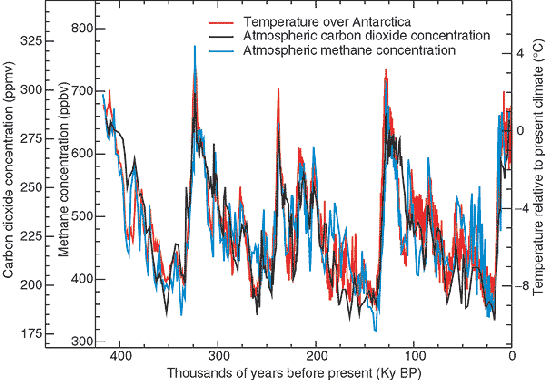(Part of the How to Talk to a Global Warming Skeptic guide)
Objection: In glacial-interglacial cycles, CO2 concentration lags behind temperature by centuries. Clearly, CO2 does not cause temperatures to rise; temperatures cause CO2 to rise.
Answer: When viewed coarsely, historical CO2 levels and temperature show a tight correlation. However, a closer examination of the CH4, CO2, and temperature fluctuations recorded in the Antarctic ice core records reveals that, yes, temperature moved first.
Nevertheless, it is misleading to say that temperature rose and then, hundreds of years later, CO2 rose. These warming periods lasted for 5,000 to 10,000 years (the cooling periods lasted more like 100,000 years!), so for the majority of that time (90% and more), temperature and CO2 rose together. This remarkably detailed archive of climatological evidence clearly allows for CO2 acting as a cause for rising temperatures, while also revealing it can be an effect of them.

The current understanding of those cycles is that changes in orbital parameters (the Milankovich and other cycles) caused greater amounts of summer sunlight to fall in the northern hemisphere. This is a small forcing, but it caused ice to retreat in the north, which changed the albedo. This change — reducing the amount of white, reflective ice surface — led to further warmth, in a feedback effect. Some number of centuries after that process started, CO2 concentrations in the atmosphere began to rise, which amplified the warming trend even further as an additional feedback mechanism.
(You can go here for a discussion of exactly this question by climate scientists, with greater technical detail and full references to the scientific literature.)
So it is correct that CO2 did not trigger the warmings, but it definitely contributed to them — and according to climate theory and model experiments, greenhouse gas forcing was the dominant factor in the magnitude of the ultimate change.
This raises a warning for the future: we may well see additional natural CO2 come out of the woodwork as whatever process took place repeatedly over the last 650K years begins to play out again. The likely candidates are out-gassing from warming ocean waters, carbon from warming soils, and methane from melting permafrost.

